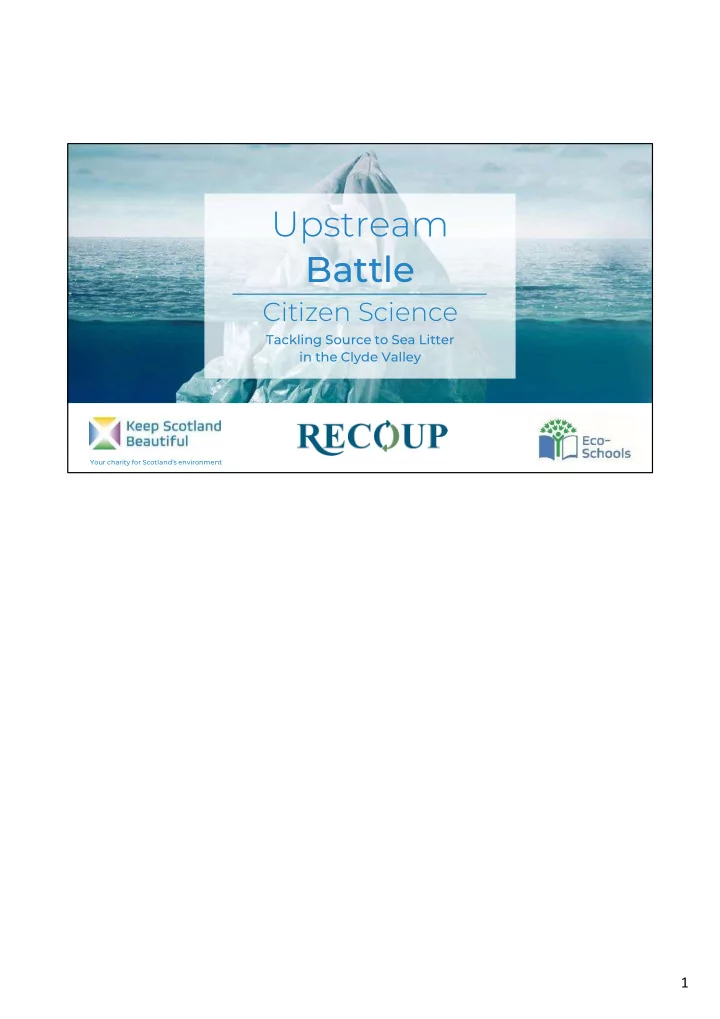

Upstream Battle Citizen Science Tackling Source to Sea Litter in the Clyde Valley Your charity for Scotland’s environment 1
You’ve just seen an image on the previous slide. What was in the picture? Here it is again on the next slide. What do you see? What could this picture be trying to show? 2
3
This powerpoint presentation covers: 1) All about Litter – what is it? And where does it come from? 2) Impacts of litter and why we need your help. 4
All about Litter 5
Hello I’m Wido! What is litter? How would you describe it to an alien? I would call it ‘Rubbish that has not been disposed of properly.’ What is litter? How would you describe it? Litter is rubbish that has not been disposed of properly. This can include crisp packets, cans, bottles, sweet wrappers, paper and other items. Has anyone seen these types of litter around the school? At home? 6
Some litter is found in the sea. This is called marine litter. It’s estimated that up to 12.7 million tonnes of plastic gets into the sea each and every year – that's a truck full of litter a minute. 7
Did you know? 80% of all marine litter comes from land. Most of the litter in the oceans was dropped on land. 8
Source to Sea Flows in To the sea pathway. streams, rivers What goes How does it get into How does litter get and drains here? the sea? from land to sea? Hi I’m Barry . Swept into water ? Fill in the courses by rain and wind blank boxes. Litter on land How does litter get from land to sea? Some litter is dropped or dumped at sea, but the litter that is in our neighbourhoods also can contribute to the litter in the sea. Rain/wind can sweep litter into rivers, through streams and drains. The rivers flow into the sea, bringing litter with them. This is called the Source to Sea pathway. 9
But wait! What is the problem with litter? Litter that enters the Clyde could end up flowing to sea and becoming marine litter. 10
Impacts of Litter. Why we need your help. 11
What problems with litter can you think of? • It is harmful to wildlife • It makes rivers and beaches messy and unclean . • It is expensive to clean up. • It’s a BIG problem - 12.7 million tonnes of plastic get into the sea each year. That is a truck full of litter Here’s some that I every minute. know about What is the impact of marine litter? These are some that you might think of: Wildlife • Animals like dolphins and seals - can become entangled in marine litter, stopping them from being able to swim. • They can also mistake it for food and fill up their bellies with plastic instead of food. This can cause them to get very sick or die. Messy beaches • Who likes going to the beach? Do you like nice golden soft sand, or littered sand? Marine litter is unpleasant to visitors and can make our beaches dirty. Expensive • It costs a lot of money & takes a lot of time to clean up litter. • Many hours spent on this, that could be spent on other things. Image credit: downtoearth.org 12
Well Pickle, the Clyde River is 109 miles long and 1.9 million people live around it. That could mean a lot of litter! Discuss pupils knowledge of the River Clyde. Where is it in relation to school? Who has been there? 13
A short video about the Upstream Battle campaign, narrated by Martin Compston. https://youtu.be/RfyYiN68nRs Transcript of the video available to download. 14
WHY do we want to learn about our litter? 1) We want to create a plan to stop the litter from happening. 2) We want law makers to make laws that keep litter out of rivers. 3) We want to know who is responsible for the litter. If we know how, where and what types of litter are getting into the river, we then have a better idea of how to fix the problem by: • Targeting people to clean up their act • Helping create a Litter Prevention Action Plan to stop it happening again • Informing future policy 15
WHAT do we want to learn about our litter? 1) Where it is getting into the river. 2) What type of litter is getting into the river. The flow of litter from source to sea means that information we can gather about litter on land (and in rivers and streams) will help us understand it’s likely impact on the ocean environment. If we want to effectively tackle marine litter, we have to better understand where and what types of litter are getting into our watercourses. The Upstream Battle campaign will help us to build a picture of how much litter, and what types of litter are entering the ocean from the River Clyde. 16
Upstream Battle Citizen Science Tackling Source to Sea Litter in the Clyde Valley #UpstreamBattle Your charity for Scotland’s environment 17
Recommend
More recommend